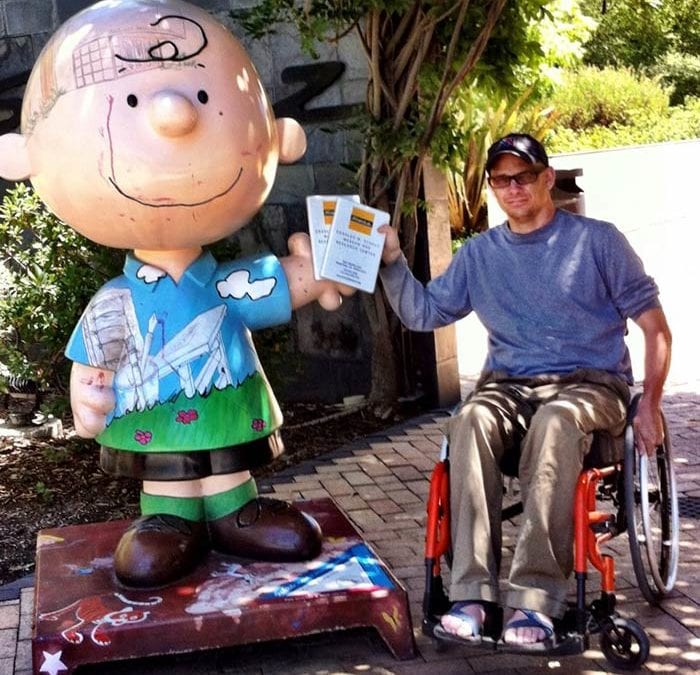I followed the Peanuts as a kid, from comic strips and television specials to birthday cards and stuffed animals. Their adventures spoke to me: the remote teacher, the sports trials, the neighborhood sparring. I reserved a special place for Snoopy. Flying Ace defeats the Red Baron. Again! When choosing a dog, my eight-year-old heart would not be moved. Beagle. I insisted on a beagle. Mazy roamed the conservation lands adjacent to my parent’s property. We wouldn’t see her for days, and then she’d appear, well-fed and wagging. I hoped her exploits rivaled Snoopy’s, but Mazy never divulged her secrets.
Given my childhood enthusiasm, why not forego another wine tasting during a recent Napa Valley vacation to pay homage to the Charles Schulz Museum in nearby Santa Rosa? I entered as eager as that fleet-footed boy who dreamed of being a sports hero, despite the grey in my scruff, the lines on my face, and my well-used wheelchair. The glass cases containing copies of significant artifacts and the historic context hung just above my view. I strained to read it all. The first comic strip was published in 1950. In the next 50 years, Schulz produced 18,000 more. That’s a long stretch. So much history. So many changes. I wasn’t caught up in the charming world of the Peanuts any more. I was thinking about the Civil Rights struggles fought in that half-century, especially for people with disabilities: the Architecture Barriers Act of 1968; Section 504 of the 1973 Rehabilitation Act; the Americans with Disabilities Act in 1991. But the Peanuts weren’t political, were they?
Charlie Brown did not have a disabled brother. And that’s a shame. A lost opportunity. The same man who captured the whimsy and innocence and struggles of childhood could have broadened his message and created a more inclusive world with lessons for us all. I started to imagine my own versions. The episode where the gang builds a ramp to the entrance of the school. Charlie Brown’s brother in his wheelchair at the mound, finally getting his team’s first strike out. Lucy stationed at her Doctor’s booth dispensing bossy but expert advice on access issues. Snoopy dozing in the sun by his wheelchair, with Woodstock perched on the handles. Charlie Brown’s brother could have helped Linus with his separation anxiety. Closer to home, the two Brown brothers might have supported each other’s dogged determination to battle the odds.
Unlike the real world, comic strips can become accessible in an instant. All it takes is awareness plus imagination. In combination. But why is that combination in such short supply? I don’t have easy answers. All I know is that I was changed by revisiting a touchstone of my past. I had to choke back some tears. I had to swallow some anger. My own nostalgia needed a jolt. Schulz built a world that shut me out. It’s up to me to create an entrance, and you can bet that it will be ramped.
I am Charlie Brown’s brother.


Bro, are you really Ralph Linus the III Earle? Glad to meetcha, Liney! Keep writing.
One of my favorite moments in visiting my Grandmother Johnson in Palm Springs was pulling out her worn copies of Charlie Brown anthologies. Many life lessons gleaned from a five panel cartoon.
I, for one, learned early on never to trust an evil girlfriend when trying to kick a field goal. 100% of the time, it turns out badly.
And, alas, it’s too late for Mr. Schultz to draw, shade and color you in… but we could always reach out to Nicole’s brother. There’s always hope. And time. http://www.foxtrot.com
Love the suggestion to reach out to Nicole’s brother and the Fox Trot folks. Great idea! Thanks!